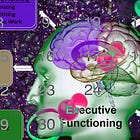ADHD and the Theory of Everything All At Once
a new video essay!
I am very excited to present this deep dive on Andrew Ivan Brown’s theory, the univocity of attention! If you’ve ever wondered why Everything Everywhere All At Once feels like watching a documentary about your brain, this might explain it.
At the beginning of the year, I started a series critiquing Russell Barkley’s concept of executive dysfunction, which I have (ironically, or I guess, fittingly), left unfinished. Digging into Andrew’s idea is part of that work, though, because I don’t think man can live on critique alone.
We need alternatives, other possibilities and avenues for sense-making, and I love this one because it takes ideas about ADHD that already exist and weaves them into something new. The response over on Youtube has already been really great — one commenter even said it made them tear up!!!
Something that keeps surfacing in reactions to this idea is the question of how it relates to monotropism, the attention tunnel theory of autism that a lot of ADHDers also find relatable as hell. Personally I like both theories and see no issue stacking them on top of each other, but I do also see how they might seem totally opposite.
Univocity is a philosophical reframing of attention. In the neurotypical sense, attention is usually described in terms of parsing and prioritizing. You look around and select one thing to pay attention to, ignoring the other things in view. But univocity describes a style of attention where you can’t easily parse one thing out from all the other things.
It’s difficult to distinguish one thing from all the other things, but that doesn’t necessarily mean that you’re multi-tasking, or that your attention is broad. You could still be doing deep, monotropic dives into your interest(s), it’s just that you don’t really see that interest as separate and discrete from everything else.
Actually, psychology researchers think that nobody is truly multi-tasking, just task-switching, which takes a lot of brain energy. Monotropic people struggle more with switching tasks — it takes more energy to change tracks, because of the intensity with which they focus on something.
Similarly, a univocal style of attention would mean that you have to do extra cognitive work to parse and prioritize the attentional field, which you are experiencing as one unified stream. Maybe univocal could describe the philosophy of your attention, where monotropic could describe its intensity and explain your behavior.
The relationship between the two ideas is definitely something to ponder more! I think there’s room for multiple frameworks, and that, like Andrew says at the end of the video, there doesn’t have to be One Theory to Rule Them All.
Last month for my critique of Sami Timimi's work, I read a book on Kant, who said that every theory is an abstraction. Scientists abstract sensory information into concepts so we can understand it, but those abstractions can only ever approximate truth. Kant thought it wasn’t really possible to fully know the true nature of the world, because we have to filter it through our limited frameworks of thought.
ADHD, autism, neurotypical, monotropic, univocity — these are all just abstractions that help us make sense of the chaos that is conscious awareness. Theories are just tools, and you’re allowed to have a whole kit of them! Fill it with the ones you like the most!



